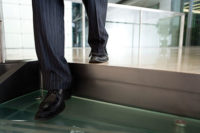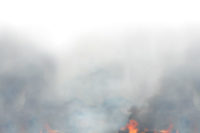
According to the National Floor Safety Institute (NFSI), the typical restaurant has as many as nine slip and fall accidents every year. With each incident the injured party typically misses up to 38 days of work, and 65 percent of lost workdays are attributed to slips and falls. Across all industries, slips and falls are the most common type of workplace injury.
Be proactive
The number of lawsuits filed as a result of slip-and- fall accidents has risen by more than 300 percent since 1980. With the average cost per lawsuit at approximately $50,000 and workers’ compensation claims averaging about $20,000 per incident, the total cost comes to more than $60 billion annually.When a slip and fall lawsuit is filed, lawyers for the plaintiff attempt to prove that the defendant, typically a business, was negligent and should have taken steps to keep the incident from occurring. The defending attorneys, on the other hand, attempt to show that all proper due diligence and commonsense precautions were in place. This can be a tough battle for the defendant, which is why so many try to settle the case before it ever reaches the courtroom.
Clearly, facility managers must take a more proactive approach toward floor safety. This starts with an assessment, or audit, that results in a detailed report documenting every step taken to identify and rectify floor problem issues. This report can serve as proof that legitimate steps and due diligence have been taken, thus protecting a facility owner against lawsuits should an accident occur.
How’s your SCOF?
A key safety issue is the static co-efficiency of friction (SCOF) of the floors. Flooring in most commercial and industrial locations must have a SCOF of 0.50 as determined by using a leather sensor and a clean and dry level walkway surface. Leather is used as a testing material because, when placed on shoe bottoms, it is considered one of the most slippery materi- als. As for the actual SCOF reading, in most cases, the higher the reading, the less slippery the floor.*When first installed, a floor may have an acceptably high SCOF which over time may be reduced, in part, because of the way the floor is maintained. Most hard surface floors are mopped using traditional methods. Instead of removing soils and contaminants, the mops actually spread contaminants around,** thus lowering the SCOF resistance.
One alternative is to use a spray-and-vac cleaning system. Spraying the cleaning solution helps loosen, dissolve, and remove grit and contaminants. A wide-area squeegee is then used to vacuum up the dust, soils, solution and slurry.
This system is considerably faster than conventional dust/wet mopping or automatic scrubbers. Once thoroughly cleaned, UL-tested or NFSI-certified*** cleaning products and sealants can be applied to improve the floor’s slip resistance.
From assessment to shoe shopping
In 1989, a pregnant employee of a major bank fell while at work. She was rushed to the hospital, and fortunately, she and her baby were not injured. When the bank’s insurance company discovered that the facility’s tile floor had been refinished just a few days earlier, they initially attempted to blame the contract cleaning company for the accident. But upon learning that the cleaning company had used a commercial grade, high-quality, slip-resistant finish, they looked further and found the real problem: although warned against it, the expectant mother often worked wearing comfortable socks and slippers instead of shoes.Although employers cannot control what workers wear at home, in the work setting they have the right — and the obligation — to insist that slip-resistant shoes be worn as part of a slip-and-fall prevention program.
Anti-fatigue and high-performance matting
In industrial and factory settings, static standing for prolonged periods of time places strain on lower ligaments and can affect blood flow through the legs, knees, and feet. This can negatively impact worker productivity and is increasingly understood as a contributing factor in slips and falls. (See sidebar.)Fortunately, this can be prevented through the use of anti-fatigue matting systems. According to Bob Moran, founder of Crown Mats and Matting, the technology behind anti-fatigue matting has evolved considerably in recent years. These mats offer a two-step action: they allow some compression when walked on and then provide a push or rebound, thus stimulating blood and muscles, lessening fatigue and helping to prevent slips and falls.
Engineered to last for a year or several years, high-performance matting helps trap and hold moisture, soils, and contaminants. Some systems have bi-level construction that allows impurities to fall below the surface of the mat. “These systems help prevent soil/ moisture from being walked into a facility as well as spread from one area to another,” says Moran. “This keeps the floor cleaner and drier, which makes it safer as well.”
Floor safety is no secret
Your floor safety assessment report should include not only the steps the facility is taking to improve safety, but also the steps workers must take to prevent slip and fall accidents. These suggested actions include wearing proper footwear, reporting wet/soiled areas, cords and torn carpets, and identifying other hazards that can cause a slip or fall. “As part of due diligence, each worker should read the report and sign that they will do their part to promote floor safety,” adds Moran. “This benefits everyone in the long run.”SIDEBAR: Tests of Anti-Fatigue Matting Systems
The Center of Ergonomics at the University of Michigan studied 14 workers at the Ford Chesterfield Trim Plant. These workers were required to stand throughout their entire shift on a variety of floor conditions, from concrete to a 3/8-inch rubber anti-fatigue mat. According to ergonomist Mark Redfern, workers forced to stand on hard concrete floors for long periods of time suffered significant levels of fatigue and discomfort in the legs and back and throughout the body. Those who stood on anti-fatigue matting systems reported reduced levels of fatigue and discomfort by as much as 50 percent.Footnotes
* There is some debate about how to test for slip resistance, especially on different floor types such as ceramic tile, polish-coated floor surfaces, cement or concrete, wood and wood-based finish flooring, painted surfaces, etc. As a result, there is more than one SCOF testing system available.** Reported by Dr. Jay Glasel, founder of Global Scientific Consulting LLC, at the Cleaning Industry Research Institute June 2008 Symposium.
*** UL stands for Underwriters Laboratories, an independent testing organization; NFSI is the National Floor Safety Institute.

